|
September 1949 Popular Science
 [Table of Contents] [Table of Contents]
Wax nostalgic about and learn from the history of early
electronics. See articles from
Popular
Science, published 1872-2021. All copyrights hereby acknowledged.
|
Nikola Tesla is usually
credited with popularizing experimentation with extremely high voltage. We've all
seen the photos of his gigantic generators discharging across a laboratory, including
the iconic picture of
Tesla sitting calmly beneath an array of deadly bolts of artificial lightning,
while looking at a book. That was a heck of a reading lamp. These photos of a test
laboratory for lightning research appeared in a 1949 issue of Popular Science
magazine. Mr. Tesla would have loved it. Interestingly, Tesla's name is never
mentioned in the article. Maybe that's because it is a
General Electric
facility, a company founded by Thomas Edison, who was a fierce competitor of Tesla
back at the turn of the last century. If this story had been about lightning research
in a Westinghouse lab, Tesla's name definitely would have been included. See "The War of the
Currents." Much has been learned about nature of lightning and ways to mitigate
the effects of it. The new battlefront for high voltage tolerance is in electronics,
where modern semiconductor devices contain junctions that can barely withstand a
dozen volts - never mind thousands. That is the science of
electrostatic discharge
(ESD).
New Generator Hurls Life-Size Lightning
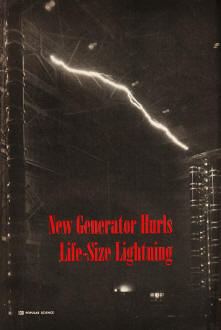
This is it - real lightning! Fifty-foot bolt
of 15,000,000 volts, mightiest ever produced by man, matches natural ones of above-average
power. Its thunderclap sounds like big gun.
By Alden P. Armagnac
Engineers wield man-made thunderbolts in awe-inspiring tests of electric devices.
PS photos on location by W. W. Morris, pages 130, 131, 132, 135.
If lightning struck within a few feet of you, and you were lucky enough to stay
alive, what would it look and sound like?
Standing behind protective wire grating in a hangar like building at Pittsfield,
Mass., you can safely learn the answers. You see a narrow streak of yellow-white
light so brilliant that its branching pattern impresses itself on the retina of
your eye - and is still visible, with your eyes shut, for some little time. Simultaneously
you hear a crash like a big gun firing, but, surprisingly, not too loud for unprotected
eardrums to stand.
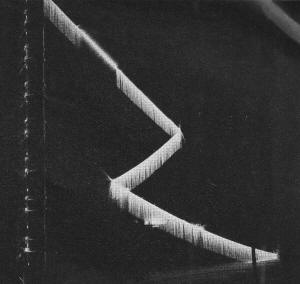
Thin copper wire, strung in
zigzag pattern, vanishes in shower of molten sparks as man-made lighting from generator
hits it. Sparks fell this far before camera's shutter closed.
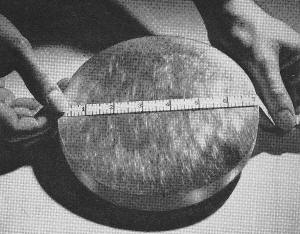
For split second, new generator yields 33,000-
ampere flow of current - an amount that would need a solid copper conductor of at
least the thickness above to carry it continuously.
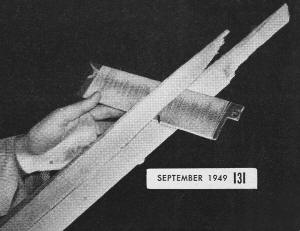
When man-made thunderbolt hit block of wood,
this fragment was hurled 50 feet. It struck a rack of resistors with such force
that one was embedded in it as shown.
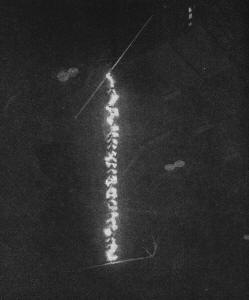
Arc of lightning generator flashes over string
of 30 insulators to measure setup's insulating effectiveness. (Twenty-four are most
used commercially.) Generator builds up voltage until current leaps between top
and bottom of string, producing the brilliant display shown above.
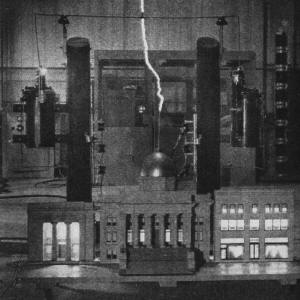
Bolt strikes transformers without putting out
lights burning in model, as lightning arresters bypass stroke harmlessly to ground.
In similar test of transformers without arresters, lightning blows fuses and lights
go out. Generator's control booth is seen in background.
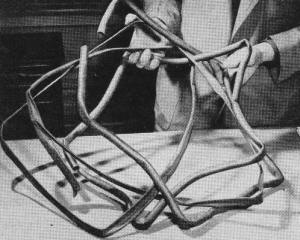
This once was a circular tuning coil in radio
station WSM, Nashville, Tenn. Then lightning hit it. Magnetic effects of huge current
crumpled coil and flattened copper tubing, as seen. Laboratory rests with copper
tubing yielded similar effects at 75,000 to 118,000 amperes.
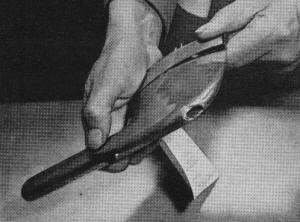
Lightning has hit many planes without harm to
passengers or serious damage to craft. All-metal construction conducts stroke without
dangerous sparks. DC-4 transport had only this small hole burned in pitot tube,
where lightning hit it, as souvenir of experience.
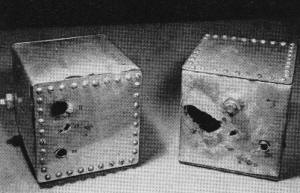
Artificial-lightning tests on sample gasoline
tanks, of 0.051-in. aluminum alloy, indicated that high-voltage spark would be fire
hazard if it struck tank directly. Bolts of high-powered man-made lightning punctured
sample tanks and ignited their inflammable contents.
In this building, General Electric engineers have just placed in operation the
mightiest artificial-lightning generator ever built. For the first time it enables
them to duplicate the "business end" - the part that strikes buildings, trees, and
power lines - of natural lightning bolts up to well-above-average power and destructiveness.
Their new "life-size lightning" machine hurls an awe-inspiring thunderbolt of
15,000,000 volts for a record distance of 50 feet through the air. For the few millionths
of a second that the giant spark lasts, the generator delivers a 33,000-ampere flow
of current. It would take a conductor of solid copper at least seven inches in diameter
to carry so many amperes continuously.
Compared with the largest previous artificial-lightning generator, the one whose
30-foot arc of 10,000,000 volts thrilled New York World's Fair visitors a decade
ago, the new one unleashes half again the voltage and nearly twice as many amperes.
Momentarily its power exceeds that of all the hydroelectric power stations in the
United States combined!
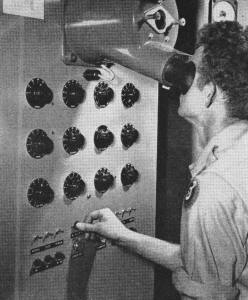
Operator touches off lightning bolt by pressing
this button, after 30-second build-up of charge on condensers and sounding of warning
horn. Eyes to oscillograph, he can see wave shape of discharge. Protective wire
grating shields his control booth from runaway flash.
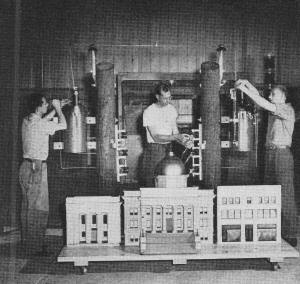
Model of city buildings, lit by power from transformers
on pole behind it, shows how modern lightning arresters prevent power failure during
electrical storm. Above, engineers are installing arresters on transformers. Grounded
lightning rod protects buildings themselves.
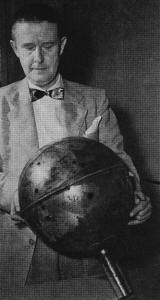
Artificial lightning, bombarding metal sphere
exhibited by Julius H. Hagenguth, GE engineer, perforated it like sieve. Measuring
current and time required to burn holes like those of sphere in photo at upper right
yielded useful data on characteristics of natural lightning.
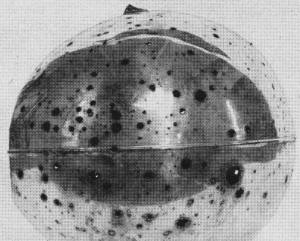
Lightning strokes burned 150 holes in ornamental
nickel-plated copper sphere atop 878-foot Tennessee radio tower - then prankishly
knocked it to earth, revealing their handiwork.
Spectacular pyrotechnics occur when experimenters "short-circuit" the generator
with a thin strand of copper wire and touch a button that releases the lightning
bolt. Wham! The wire disappears in a puff of smoke and a fiery shower of molten
sparks. That's presumably what happens, engineers suggest, to a radio aerial struck
by lightning.
With the new generator, they tried a stunt they have performed with smaller ones
- splitting a block of wood into kindling with artificial lightning. This time,
a piece of the wood hurtled 50 feet through the air and crashed into a resistor
rack, with such force that a resistor was found deeply embedded in it. Repeat performances
were forthwith tabooed as too dangerous to spectators and equipment.
In more scientific tests, engineers use the new generator to find out what happens
when natural lightning hits transformers, insulators, lightning arresters, and transmission
lines.
An arc from the generator flames over a string of insulators, suspended high
in the air, to measure their insulating effectiveness. And to study what happens
to a power line hit by lightning, one of the generator's twin sections rolls bodily
outdoors on a rail car, to bombard a 1 1/2-mile-long experimental transmission line
with a flash that has been seen and heard two miles away.
Moved outdoors, one of generator's twin sections hits transmission
line with 25-foot bolt of 7,500,000 volts. Flash has been seen and heard two miles
away. Portable section of generator rides rail car along track through high door
in laboratory wall, seen open in picture.
Inside view of towering section of generator shows metal spheres
that act as switches. A fly alighting on one of them alters the geometrically perfect
spherical shape on which their delicate adjustment depends, and plagues experimenters
by causing a premature discharge.
The generator is built in two, 44-foot-tall sections, each made up of black columns
ringed with silvery stainless steel. Operating independently, each section builds
up 7,500,000 volts, and their combined power gives the generator's 15,000,000-volt
total. The black stacks are banks of electrical condensers, storing electricity
as do the cumulus clouds or "thunderheads" of electrical storms.
For a 30-second charging period, current at comparatively moderate voltage feeds
the condensers, which are connected meanwhile "in parallel" - like appliances you
plug into a house circuit. That is, all the condensers get the same charge - building
voltage, independently of the others. Then a tricky switching arrangement reconnects
the condensers "in series," so that the voltage of the charge stored on each is
added together to yield a thunderbolt. Invention of this "Marx circuit" by E. Marx
in 1925 led to the first artificial-lightning generator, of 1,000,000 volts and
its successors of increasing power.
Even the present 15,000,000-volt machine is far from the theoretical limit of
voltage attainable by such an "impulse generator," declares Julius H. Hagenguth,
engineer in charge of the GE high-voltage laboratory. By increasing the number of
condensers, a still more powerful one could be built. Practical limits are the cost
of the machine itself, against advantages to be gained, and the size of the huge
building required to house it. Increasing voltage calls for more and more clearance
from walls, ceiling, and other apparatus to prevent stray bolts. For the 15,000,000-volt
machine, this minimum clearance is 33 feet. "High-Voltage Hall," its great windowless
test chamber, measures no less than 165 feet long, 95 feet wide, and 85 feet high.
Three 1,000,000-volt, 60-cycle transformers share this enormous room with the
black-and-silver towers of the new generator. Applied to a spark gap, their own
discharge aids studies of high-voltage action - and incidentally creates one of
the most beautiful of all displays of electrical fireworks, illustrated below.
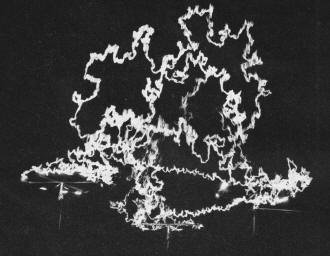 Electric fire of 1,000,000 volts,
from three-phase 50-cycle transformers, gives spectacular display as it leaps nine-foot
gaps between rotating "pinwheel" electrodes. These whirl of own accord as electricity
escapes from their backward-turned points. Arc is carried 20 feet high by heated
air currents and is colored red, yellow, and green by chemicals tipping the three
electrodes. Sound effect of electrical fireworks resembles drone of airplane, punctuated
every few seconds by a sharp crack as a new arc is struck between pair of electrodes. Electric fire of 1,000,000 volts,
from three-phase 50-cycle transformers, gives spectacular display as it leaps nine-foot
gaps between rotating "pinwheel" electrodes. These whirl of own accord as electricity
escapes from their backward-turned points. Arc is carried 20 feet high by heated
air currents and is colored red, yellow, and green by chemicals tipping the three
electrodes. Sound effect of electrical fireworks resembles drone of airplane, punctuated
every few seconds by a sharp crack as a new arc is struck between pair of electrodes.
Most impressive of the machines in adjacent rooms of the Pittsfield laboratory
is a "high-current" impulse generator. It delivers the staggering current of 260,000
amperes with a respectable thunderclap of its own. While its artificial lightning
lacks the voltage to leap great gaps, it will subject small test specimens to more
than the record 200,000 amperes ever measured in a natural lightning stroke.
Virtually any of lightning's pranks, of which some are illustrated here, can
now be matched by GE engineers with these machines. Using their findings to perfect
economical and trouble-proof power-line equipment, they are constantly reducing
the "electrical cost of living" for the ultimate consumer.
Posted March 14, 2024
|
























